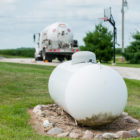The History of Propane and Some Basic Propane Facts
The average person may not spend very much time thinking about propane unless the tank on the family’s propane grill needs to be changed out to get ready for this weekend’s cookout. But propane has an interesting story to tell. Read on to discover more about propane, propane’s history, and the positive impact that the propane industry has on the American economy.
The Properties of Propane
At room temperature, and under normal atmospheric pressure, propane is a gas. In fact, in order to get propane to change into its liquid form, you have to either cool it to below its boiling point of -43.6 degrees Fahrenheit, or put it under pressure. Since liquid propane will become a gas when released from a pressurized container, there’s no need for an intermediary vaporizing device when you wish to use it. This makes propane well-suited for portable stoves, since turning the valve on the tank releases the fuel, ready to burn.
Though propane has no color or odor of its own, it is odorized during processing to make its presence detectable. If propane is simply released into the open air, it will dissipate. On the other hand, if it is leaked into a closed space, propane gas will settle along the ground as it is heavier than air.
How Do You Get Propane?
Propane is produced as a byproduct of both the processing of natural gas and the refining of oil. After production, but before transport, propane is liquified. When in its liquid form, propane is 270 times denser than it is as a gas. This allows for propane to be transferred via pipe systems to large storage facilities where it awaits delivery by trucks, ships, and trains to its destination.
The Earliest Days of the Propane Industry
Although the initial discovery of propane dates to the middle of the 1800s, in France, it wasn’t until the 1910s that the propane industry was launched in the United States. This happened when Dr. Walter O. Snelling, a chemist for the U.S. Bureau of Mines, experimented with vapors escaping from a gasoline tank and discovered that these vapors could be liquified and used as a fuel source for lighting and heating.
Propane and the Economy
Today, propane ranks third, behind only electricity and natural gas, as the fuel used in the most American households. In the state of Georgia alone, propane was the primary heating source for more than 180,000 homes (as of 2015). In that same year, Georgians’ demand for propane topped 205 million gallons, and propane sales, transportation, and storage added more than $800,000 to Georgia’s economy!
In Conclusion
Scientific facts about propane are enlightening, but it’s the way that propane helps fuel the economy that matters the most.
If you want to discover how propane can work for you, reach out to the professionals at Southeast Quality Propane!






Recent Comments